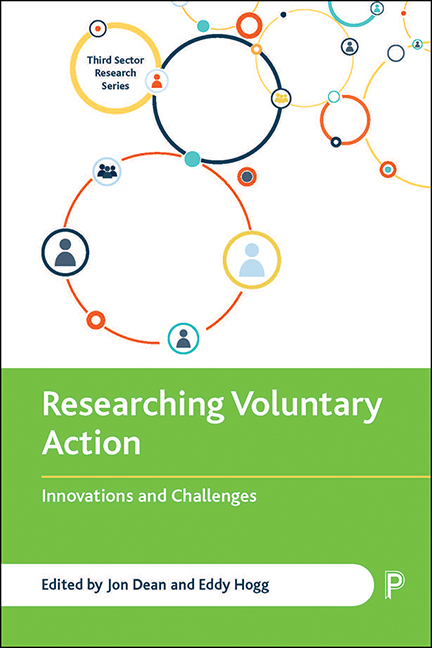Book contents
- Frontmatter
- Contents
- List of figures, tables and boxes
- Notes on contributors
- Acknowledgements
- Series editor’s foreword
- 1 Introduction
- 2 (Un)suitable methods and reflexive considerations: an interview and focus group study of youth volunteering
- 3 Interpretive ethnography: a UK charity shop case study
- 4 Collaborative philanthropy and doing practically relevant, critical research
- 5 Peer research: co-producing research within the context of voluntary and community action
- 6 Charity advertising: visual methods, images and elicitation
- 7 Using archives and objects in voluntary action research
- 8 Using Mass Observation as a source of qualitative secondary data for interdisciplinary longitudinal research on voluntary action
- 9 Investigating meanings and messages on volunteering through television media
- 10 Annual reporting in voluntary organisations: opportunities for content analysis research
- 11 Researching risk in the voluntary sector: the challenges and opportunities of regulatory data
- 12 Exploring the benefits of volunteering: combining survey and administrative data in the Nordic ‘laboratory’
- 13 Spatial approaches to the voluntary sector
- 14 Restudies, surveys and what counts as volunteering
- 15 Conclusion
- References
- Index
6 - Charity advertising: visual methods, images and elicitation
Published online by Cambridge University Press: 15 September 2022
- Frontmatter
- Contents
- List of figures, tables and boxes
- Notes on contributors
- Acknowledgements
- Series editor’s foreword
- 1 Introduction
- 2 (Un)suitable methods and reflexive considerations: an interview and focus group study of youth volunteering
- 3 Interpretive ethnography: a UK charity shop case study
- 4 Collaborative philanthropy and doing practically relevant, critical research
- 5 Peer research: co-producing research within the context of voluntary and community action
- 6 Charity advertising: visual methods, images and elicitation
- 7 Using archives and objects in voluntary action research
- 8 Using Mass Observation as a source of qualitative secondary data for interdisciplinary longitudinal research on voluntary action
- 9 Investigating meanings and messages on volunteering through television media
- 10 Annual reporting in voluntary organisations: opportunities for content analysis research
- 11 Researching risk in the voluntary sector: the challenges and opportunities of regulatory data
- 12 Exploring the benefits of volunteering: combining survey and administrative data in the Nordic ‘laboratory’
- 13 Spatial approaches to the voluntary sector
- 14 Restudies, surveys and what counts as volunteering
- 15 Conclusion
- References
- Index
Summary
Introduction
Visual methods – those methods that utilise photography, video, drawings, art and other similar materials – are underused in research on voluntary action. This is despite such methodological approaches gaining widespread recognition across the social sciences, arts and humanities as important ways of documenting the full gamut of human social experience and being shown to break down boundaries between researchers and participants (including vulnerable or disadvantaged populations). Visual approaches offer ‘complex, reflexive and multi-faceted ways of exploring social realities’ (Spencer, 2011: 35), and ultimately make statements that cannot be made solely with words (Harper, 1988: 38; Gauntlett, 2007: 106).
In this chapter we discuss two separate studies we have conducted separately with our colleagues Angela Eikenberry and Beth Breeze, which utilised visual methodologies to explore the representation of need in charity fundraising and advertising materials. These studies offer comparative insight into what charity beneficiaries (children in India, and homeless people in the UK) think about their representation, and how they think the services they benefit from should be illustrated.
This chapter first explores the nature of visual methods and examines how and why they have been underutilised in voluntary sector research. The main body of the chapter will then focus on the role visual methods can play in helping us to research and understand charity advertising and fundraising materials, which is important because these visuals are often the way in which most people see, understand and engage with the work of charities to which they are not direct beneficiaries.
Using visual methods
While the study of the voluntary sector is a broad church in terms of disciplinary approaches, it seems strange that such a diverse, creative and representational part of research design has not played a significant part in our academic explorations of philanthropy, volunteering or the work of non-profit organisations. There has been a long history of incorporating the visual into studies of community, work, sport and recreation and everyday life, all fields of research with a deep connection and relevance to voluntary sector researchers.
- Type
- Chapter
- Information
- Researching Voluntary ActionInnovations and Challenges, pp. 59 - 69Publisher: Bristol University PressPrint publication year: 2022



